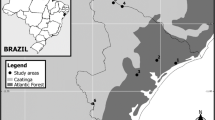Abstract
Host attachment sites and frequency distribution of parasitism were investigated for the larval erythraeid mite Leptus indianensis parasitising a sample of 500 harvestmen, Leiobunum formosum in Tennessee, USA. A significant difference was found in the number of mites attached to different body segments of the harvestmen with the greatest number of mites attached to femurs I–IV. Scanning electron microscopy revealed that the mites attached to smooth areas of the host integument between rows of stout setae. The frequency distribution of mites parasitising the harvestman population was highly clumped (Coefficient of Dispersion = 3.34) with a relatively small number of hosts being parasitised by most of the mites.
Similar content being viewed by others
References
Åbro, A. 1988. The mode of attachment of mite larvae (Leptus spp.) to harvestmen (Opiliones). J. Nat. Hist. 22: 123–130.
Andrés, J.A. and Cordero, A. 1998. Effects of water mites on the damselfly Ceriagrion tenellum. Ecol. Entomol. 23: 103–109.
Baker, G.T. 1982. Site attachment of a protelean parasite (Erythraeidae: Leptus). Experientia 38: 923.
Binns, E.S. 1975. A reassessment of the numerical distribution of watermites (Arrenurus spp.) on dragonflies in relation to parasitism and dispersal. Acarologia, Paris 14: 529–535.
Boag, B., Hackett, C.A. and Topham, P.B. 1992. The use of Taylor's Power law to describe the aggregated distribution of gastro-intestinal nematodes in sheep. Internat. J. Parasitol. 22: 267–270.
Cokendolpher, J.C. 1993. Pathogens and parasites of Opiliones (Arthropoda: Arachnida). J. Arachnol. 21: 120–146.
Fain, A., Gummer, S.L. and Whitaker, Jr., J.O. 1987. Two new species of Leptus Latreille, 1796 (Acari, Erythraeidae) from the USA. Internat. J. Acarol. 13: 135–140.
Kitron, U.D. 1980. The pattern of infestation of the beach-hopper amphipod Orchestoidea corniculata, by a parasitc mite. Parasitology 81: 235–249.
Krebs, C.J. 1999. Ecological methodology, Benjamin Cumming Press, New York, p. 250.
Lanciani, C.A. 1984. Crowding in the parasitic stage of the water mite Hydrachnella virella (Acari: Hydrachnidae). J. Parasitol. 70: 270–272.
Lanciani, C. A. 1986. Reduced survivorship in Dasyhelea mutabilis (Diptera: Ceratopogonidae) parasitized by the water mite Tyrellia circularis (Acariformes: Limnesiidae). J. Parasitol. 72: 613–614.
Leung, B. 1998. Aggregated parasite distributions on hosts in a homogeneous environment: examining the Poisson null model. Internat. J. Parasitol. 28: 1709–1712.
Mitchell, R. 1998. The behavior of Arrenurus larvae (Acari: Hydrachnidae) parasitizing Diptera. Acarologia, Paris 39: 49–55.
Reilly, P. and McCarthy, T.K. 1993. Attachment site selection of Hydrachna and Elyais (Acari, Hydrachnellae) watermite larvae infecting Corixidae (Hemiptera, Heteroptera). J. Natural History 27: 599–607.
Rékási, J., Rózsa, L. and Kiss, B.J. 1997. Patterns in the distribution of avian lice (Phthiraptera: Amblycera, Ischnocera). J. Avian Biol. 28: 150–156.
Smith, G. and Guerrero, J. 1993. Mathematical models for the population biology of Ostertagia ostertagi and the significance of aggregated parasite distributions. Vet. Parasitol. 46: 243–257.
Southcott, R.V. 1992. Revision of the larvae of Leptus Latreille (Acarina: Erythraeidae) of Europe and North America, with descriptions of post-larval instars. Zool. J. Linn. Soc. 105: 1–153.
Welbourn, W.C. 1983. Potential use of trombidioid and erythraeoid mites as biological control agents of insect pests. University of California (Berkeley) Agricultural Experiment Station Special Publications 3304: 103–140.
Wells, O.C. 1974. Scanning electron microscopy. McGraw-Hill, New York.
Wendt, F.E., Olomski, R. Leimann, J. and Wohltmann, A. 1992. Parasitism, life cycle and phenology of Leptus trimaculatus (Hermann, 1804) (Acari: Parasitengonae: Erythraeidae) including a description of the larva. Acarologia Paris 33: 55–68.
Young, O.P and Welbourn, W.C. 1987. Biology of Lasioerythraeus johnstoni (Acari: Erythraeidae) ectoparasitic and predaceous on the tarnished plant bug, Lygus lineolaris (Hemiptera: Miridae), and other arthropods. Ann. Entomol. Soc. Am. 80: 244–250.
Young, O.P. and Welbourn, W.C. 1988. Parasitism of Trigonotylus doddi (Heteroptera: Miridae) by Lasioerythraeus johnstoni (Acari: Erythraeidae), with notes on additional hosts and distribution. J. Entomol. Sci. 23: 269–273.
Author information
Authors and Affiliations
Rights and permissions
About this article
Cite this article
McAloon, F., Durden, L.A. Attachment Sites and Frequency Distribution of Erythraeid Mites, Leptus Indianensis (Acari: Prostigmata), Ectoparasitic on Harvestmen, Leiobunum Formosum (Opiliones). Exp Appl Acarol 24, 561–567 (2000). https://doi.org/10.1023/A:1026554308826
Issue Date:
DOI: https://doi.org/10.1023/A:1026554308826




